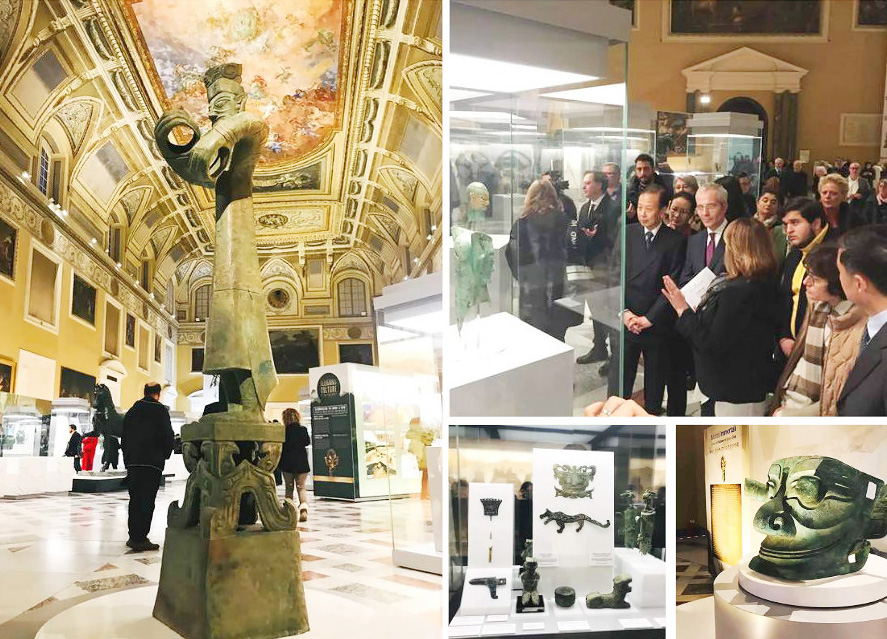Mysterious legacy of Sanxingdui goes on display in Italy

The 2.62-meter-tall statue (Left) unearthed from the Sanxingdui site and other artifacts at the exhibition in Italy. Photo: Sanxingdui Museum
As the renowned scholar Li Xueqin said, the value and role of Sanxingdui should be recognized in the scope of world history and global academic history no less than that of Troy or Nineveh. More than a regional archaeological discovery in Sichuan, the Sanxingdui civilization has contributed to the Chinese civilization and the civilization of the world.
This is also the reason why the recent “A World of God and Man: Exhibition of Ancient Civilization in Sichuan,” at the National Archaeological Museum of Naples, has solicited so much attention.
This exhibition gathered 131 pieces (sets) of relics collected by the museums across Sichuan Province. These collections can be dated back to the period between about 1600 BCE (the Shang Dynasty) and 220 CE (the Han Dynasty), covering goldware, bronze statues, jade ware, lacquered woodware, lifelike pottery figurines and portrait bricks. Many are precious relics featuring strange design, mysterious exotic taste, unique patterns and bold color contrast, giving clues as to this ancient people’s artistic imagination and great creativity.
At the exhibition hall, the preface illustrates Sichuan’s geographical location, historical development and its correspondence with world civilization, so that visitors can have a rough idea about this place. At the same time, the background information about Sanxingdui and other archaeological sites is introduced in the form of plates and videos supplemented with a display of the ancient ancestors’ daily necessities.
The first part aims to reveal the mystery and romance of the Shu region’s early civilization through the essence of ancient relics such as the Sanxingdui site, the Jinsha site, and the tomb cluster in Shuangyuan Village. It presents the sacrificial life and religious rituals of the ancient people through bronze statues, bronze god statues, and wares of gold, bronze, jade and stone. Among them is a 2.62-meter-tall bronze statue, a large monument that was rare in the world 3,000 years ago. It wears a crown and a vestment, standing straight and barefoot on a cloud-patterned base supported by four elephant heads. With two large hands held in front of his chest, he holds his implements high as if he were commanding a major sacrifice. The exhibit also conveys the spiritual world of the ancient Shu people, who believed that everything had a soul. This is shown through exhibition of the Golden Sun Bird, animal-shaped bronzeware, magical bronze trees and other artifacts.
The second part of the exhibit is mainly about the Han portrait bricks and ceramic animal statues unearthed in the Shu region, showcasing human wellbeing and commercial prosperity. The exhibit ranges from scenes of busy social production, such as agriculture and handicrafts, to scenes related to traffic, working life, acrobatics, music and dance, reproducing the area’s prosperity during the Han Dynasty. Finally, it introduces the ancestral view of how the dead and the living should be treated the same. This constitutes an ideal unity of nature and man and the coexistence of humans and gods, reflecting ancestors’ respect toward nature and the world throughout the period.
The first leg of the exhibition tour was the National Archaeological Museum of Naples, which was built in the late 18th century by Charles from the Bourbon royal family. Its collection of ancient Roman artifacts is second to none in Europe, especially its treasures found in Pompeii and Herculaneum. There are also many beautiful relics such as portraits, sculptures and bronzes from the golden ages of Greece and Egypt. In the same exhibition hall, Sanxingdui’s cultural relics and the museum’s 19th century paintings of mythology and history both feature humans and gods, matching the theme of the exhibition.
A sundial on the ground echoes the Shu ancestors’ worship of the sun. At the same time, a bronze statue of Apollo and horses stands beside Sanxingdui’s bronze statues and horses to form a dialogue between the treasures of the East and West without the constraints of time and space.
The Sanxingdui site has made a unique contribution to exploring the Chinese civilization. The Chinese Bronze Age, represented by the Xia, Shang and Zhou dynasties, symbolizes the formation of early Chinese civilization. The archaeological finds of Sanxingdui have shown that the ritual system stemming from the Central Plains also affected the distant ancient Shu area. Among the hundreds of items of bronzewares unearthed from the two sacrificial pits, there were Central Plain ceremonial wares such as urn-shaped bronze wine containers. The two cultures coexisted and interacted. At the same time, Sanxingdui has another system based on golden scepters, bronze statues, large masks and mysterious trees, which shows the diversity of bronze civilization and enriches the understanding of how Chinese civilization originated and formed.
The Sanxingdui civilization shows characteristics of both Eastern and Western civilizations, and it is a brilliant product of early China-foreign cultural exchanges. Based on the traditional Central Plains civilization and the distinctive Shu civilization, it has absorbed elements from other ancient civilizations and embodied unique and interesting cultural choices, thus presenting a magnificent exhibit.
Since 1993, the cultural relics department of Sichuan Province, supported by the national government, has organized 21 overseas exhibitions and 33 domestic exhibitions focusing on Sanxingdui and Jinsha cultural relics. The profound ancient Shu civilization has stolen the spotlight everywhere it has arrived. This exhibition will come to other places in Italy and will continue to be promoted around the world.
The current understanding of the Sanxingdui civilization is just the tip of the iceberg. More discoveries remain to be unveiled through future archaeological and multidisciplinary research.
This article was translated from People’s Daily.
(edited by MA YUHONG)

 PRINT
PRINT CLOSE
CLOSE